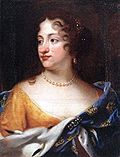
Jacques d'Agar
Encyclopedia

History painting
History painting is a genre in painting defined by subject matter rather than an artistic style, depicting a moment in a narrative story, rather than a static subject such as a portrait...
, but
he soon abandoned history for portraiture, in which branch of art he became very successful. In 1675 he was admitted into the Academy
Académie de peinture et de sculpture
The Académie royale de peinture et de sculpture , Paris, was founded in 1648, modelled on Italian examples, such as the Accademia di San Luca in Rome. Paris already had the Académie de Saint-Luc, which was a city artist guild like any other Guild of Saint Luke...
, and he became also painter in ordinary to the king and his court. Upon the revocation of the Edict of Nantes
Edict of Nantes
The Edict of Nantes, issued on 13 April 1598, by Henry IV of France, granted the Calvinist Protestants of France substantial rights in a nation still considered essentially Catholic. In the Edict, Henry aimed primarily to promote civil unity...
, Agar, as a Protestant, was shut out from the Academy. He accordingly left France in 1682—never to return.
He was invited to the court of Denmark, and was greatly patronized by King Christian V
Christian V of Denmark
Christian V , was king of Denmark and Norway from 1670 to 1699, the son of Frederick III of Denmark and Sophie Amalie of Brunswick-Lüneburg...
. The portrait of this painter, by himself, has found a place in the Florentine
Florence
Florence is the capital city of the Italian region of Tuscany and of the province of Florence. It is the most populous city in Tuscany, with approximately 370,000 inhabitants, expanding to over 1.5 million in the metropolitan area....
Gallery of Artists. It was painted, in 1693, by request of King Christian. Walpole
Horace Walpole, 4th Earl of Orford
Horatio Walpole, 4th Earl of Orford was an English art historian, man of letters, antiquarian and Whig politician. He is now largely remembered for Strawberry Hill, the home he built in Twickenham, south-west London where he revived the Gothic style some decades before his Victorian successors,...
tells us that he visited England, where he resided some time, and met with success. He painted the portraits of several of the nobility of Queen Anne
Anne of Great Britain
Anne ascended the thrones of England, Scotland and Ireland on 8 March 1702. On 1 May 1707, under the Act of Union, two of her realms, England and Scotland, were united as a single sovereign state, the Kingdom of Great Britain.Anne's Catholic father, James II and VII, was deposed during the...
's reign; among whom were the Duchess of Montagu, the Countesses of Rochfort and Sunderland, Thomas Earl of Strafford, and others. A portrait of Charles II of England
Charles II of England
Charles II was monarch of the three kingdoms of England, Scotland, and Ireland.Charles II's father, King Charles I, was executed at Whitehall on 30 January 1649, at the climax of the English Civil War...
, by him, is said to have been formerly in the Gallery at Christiansburg. He died in 1716 in Copenhagen
Copenhagen
Copenhagen is the capital and largest city of Denmark, with an urban population of 1,199,224 and a metropolitan population of 1,930,260 . With the completion of the transnational Øresund Bridge in 2000, Copenhagen has become the centre of the increasingly integrating Øresund Region...
.

